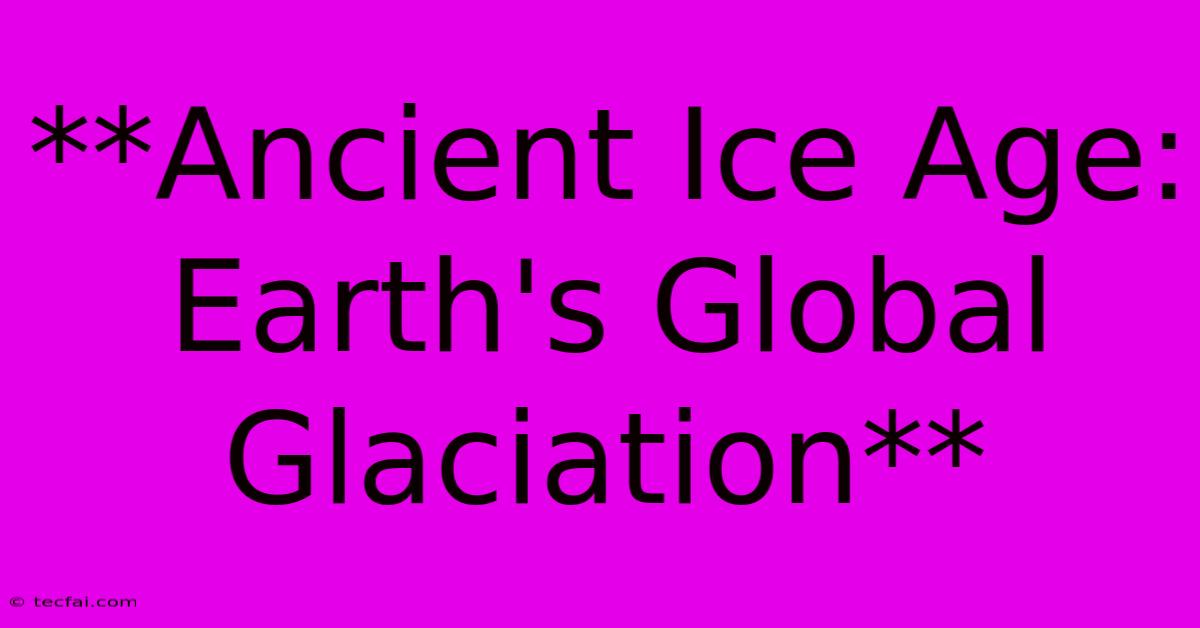**Ancient Ice Age: Earth's Global Glaciation**

Discover more detailed and exciting information on our website. Click the link below to start your adventure: Visit Best Website tecfai.com. Don't miss out!
Table of Contents
Ancient Ice Age: Earth's Global Glaciation
The Earth's history is a grand tapestry woven with periods of dramatic climate shifts, none more awe-inspiring than the Ice Ages. These epochs, characterized by vast, sprawling glaciers and dramatic drops in global temperatures, have shaped the planet's landscapes, influenced the evolution of life, and left behind a legacy of wonder and intrigue.
The Pleistocene Epoch: An Era of Glacial Cycles
The most recent Ice Age, known as the Pleistocene Epoch, spanned from roughly 2.6 million to 11,700 years ago. This period was not a single, continuous freeze but rather a series of glacial cycles, with alternating periods of glaciation and interglacials. During glacial periods, massive ice sheets, some miles thick, covered much of the Northern Hemisphere, extending as far south as the Great Lakes region in North America and the British Isles in Europe.
Understanding the Drivers of Glaciation
The exact mechanisms behind the Ice Ages remain a subject of scientific exploration. However, several key factors are believed to play significant roles:
- Milankovitch Cycles: These are long-term variations in Earth's orbital parameters – eccentricity (shape of Earth's orbit), obliquity (tilt of Earth's axis), and precession (wobble of Earth's axis). These cyclical changes affect the amount of solar radiation reaching Earth's surface, impacting global climate patterns.
- Tectonic Plate Movement: The slow, continuous movement of Earth's tectonic plates can influence ocean currents and atmospheric circulation, ultimately impacting global temperatures.
- Greenhouse Gas Concentrations: The levels of greenhouse gases like carbon dioxide and methane in the atmosphere directly influence the Earth's ability to retain heat.
Evidence of Glaciation: A Landscape Shaped by Ice
The remnants of the Pleistocene ice sheets are evident throughout the world, leaving behind:
- Glacial Landforms: The movement of massive glaciers has carved out valleys, sculpted mountains, and deposited vast amounts of sediment, creating unique landforms such as U-shaped valleys, cirques, and moraines.
- Glacial Deposits: These include till, a mixture of unsorted rock and sediment, and outwash, sorted sediment deposited by meltwater streams.
- Sea Level Fluctuations: During glacial periods, water was locked up in ice sheets, resulting in lower sea levels. As the ice sheets melted during interglacial periods, sea levels rose, affecting coastlines and shaping marine ecosystems.
The Impact of Ice Ages: A World Transformed
The Ice Ages profoundly impacted the Earth's environment and the evolution of life:
- Species Extinction: The dramatic climate shifts and habitat changes during glaciation led to the extinction of numerous species, including megafauna like mammoths and saber-toothed cats.
- Species Adaptation: The Ice Ages also drove evolutionary adaptation in surviving species, leading to the development of unique traits and behaviors.
- Human Migration: As ice sheets expanded and contracted, human populations migrated across continents, adapting to changing environments and contributing to the dispersal of human populations worldwide.
A Legacy of Wonder and Scientific Inquiry
The Ice Ages are not just a distant chapter in Earth's history. They continue to fascinate scientists and inspire awe in those who appreciate the planet's dynamic nature. The study of these ancient glacial periods helps us understand the Earth's climate system, its sensitivity to change, and the potential consequences of future climate shifts.
Exploring the remnants of Ice Age glaciers, from glacial valleys to fossil remains, provides a glimpse into a world dramatically different from our own. It is a testament to the power of natural forces and the enduring resilience of life on Earth.

Thank you for visiting our website wich cover about **Ancient Ice Age: Earth's Global Glaciation**. We hope the information provided has been useful to you. Feel free to contact us if you have any questions or need further assistance. See you next time and dont miss to bookmark.
Featured Posts
-
This Weeks Sky Supermoon And Fireball Show
Nov 14, 2024
-
Beaver Moon Arriving Soon
Nov 14, 2024
-
Ind Vs Sa 3rd T20 I India Claims Victory By 11 Runs
Nov 14, 2024
-
Dave Coulier Opens Up About Health Condition
Nov 14, 2024
-
Draisaitls Overtime Goal Secures Oilers Victory
Nov 14, 2024
